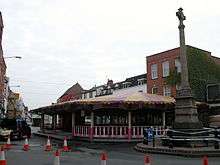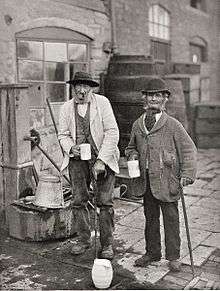Hiring and mop fairs
Hiring fairs were also called statute, or mop fairs.[1] They date from the time of Edward III, and his attempt to regulate the labour market by the Statute of Labourers in 1351 at a time of a serious national shortage of labour after the Black Death. Subsequent legislation, in particular the Statute of Apprentices of 1563, legislated for a particular day when the high constables of the shire would proclaim the stipulated rates of pay and conditions of employment for the following year.[2] Because so many people gathered at a fair, it quickly turned into the major place for matching workers and employers.[3] Hiring fairs continued well into the 20th century, up to the Second World War in some places but their function as employment exchanges was diminished by the Corn Production Act 1917. This legislation guaranteed minimum prices for wheat and oats, specified a minimum wage for agricultural workers and established the Agricultural Wages Board, to ensure stability for farmers and a share of this stability for agricultural workers.
Annual hiring fairs were held, during Martinmas week at the end of November, in the market towns of the East Riding of Yorkshire in places like Beverley, Bridlington, Driffield, Hedon, Hornsea, Howden, Hull, Malton, Patrington, Pocklington, and York.[4] Both male and female agricultural servants would gather in order to bargain with prospective employers and, hopefully, secure a position for the coming year. The yearly hiring included board and lodging for single employees for the whole year with wages being paid at the end of the year's service. These fairs attracted all the other trappings of a fair, and they turned into major feasts in their own right, and attracted poor reputations for the drunkenness and immorality involved.[5] Later, when wage rates and conditions were no longer officially set, the hiring fair remained a useful institution, especially as much employment in rural areas was by annual agreement. Prospective workers would gather in the street or market place, often sporting some sort of badge or tool to denote their speciality. Shepherds held a crook or a tuft of wool, cowmen brought wisps of straw, dairymaids carried a milking stool or pail and housemaids held brooms or mops; this is why some hiring fairs were known as mop fairs. Employers would look them over and, if they were thought fit, hire them for the coming year, handing over a shilling to seal the arrangement.[6]
History

Farm workers, labourers, servants and some craftsmen would work for their employer from October to October. At the end of the employment they would attend the mop fair dressed in their Sunday best clothes and carrying an item signifying their trade. A servant with no particular skills would carry a mop head . The 'tassle' worn on their lapel was the emblem of the employee's trade and was known as a 'mop' — hence the term "mop fair"... Hiring fairs were also known as statute fairs (or statutes) because an Act of Parliament of 1677 endorsed the yearly bonds made between masters and servants at them.[7]
Employers would move amongst them discussing experience and terms, and once agreement was reached the employer would give the employee a small token of money and the employee would remove the item signifying their trade and wear bright ribbons to indicate they had been hired. They would then spend the token amongst the stalls set up at the fair which would be selling food and drink and offering games to play.
Michaelmas Day is celebrated on 29 September but mop fairs were tied to the seasons and the harvest, not the calendar. When the Gregorian calendar was adopted in 1752 and eleven days dropped from that year, events associated with the end of the harvest moved eleven days later to 10 October. This date is known as "Old Michaelmas Day" and since 1752 has been the date mop fairs take place.
Mop towns


The following towns have a history of holding mops and still hold one each year on or around Michaelmas Day. A theme common to these towns is that they were, several hundred years ago, medium-sized thriving market towns surrounded by a large number of smaller villages, hence their obvious choice as the location for the mop.
- Alcester
- Banbury
- Burton upon Trent
- Chipping Norton[8]
- Chipping Sodbury
- Cirencester
- Daventry
- Evesham
- Kings Norton
- Marlborough
- Moreton in Marsh
- Stratford upon Avon
- Tewkesbury
- Warwick
- Southam
Modern mops
Tewkesbury and other mop fairs typically take over the entire town centre for two days, attracting thousands of visitors. Many of the rides at the mop are fast, brightly lit and very noisy including traditional rides such as carousels and helter-skelters.
At Ashby-de-la-Zouch Ashby Statutes is held every September. Instituted by Royal Statute, it was originally a hiring fair.
See also
- Dudsday - a hiring fair at Kilmarnock in Scotland.
References

- ↑ "The Farmer's Magazine - Google Books". books.google.co.uk. Retrieved 2009-11-05.
- ↑ "Journal of Agriculture - Google Books". books.google.co.uk. Retrieved 2009-11-05.
- ↑ "Peak district local history, customs, wildlife, transport - Peakland Heritage". Peak land heritage. Retrieved 2009-11-05.
- ↑ "Pocklington History - Pocklington Hiring Fair". Pocklingtonhistory.com. Retrieved 2009-11-05.
- ↑ "The Changing Countryside in ... - Google Books". books.google.co.uk. Retrieved 2009-11-05.
- ↑ "Observations on the Popular ... - Google Books". books.google.co.uk. Retrieved 2009-11-05.
- ↑ Hey, David (1996) The Oxford Companion to Local and Family History. Oxford University Press; p. 218
- ↑ Chipping Norton at OXTowns.co.uk
Further reading
- Kussmaul, Ann (1981) Servants in Husbandry in Early Modern England (includes a list of hiring fairs which existed in that period)
- Caunce, Stephen (1991) Amongst Farm Horses: the horselads of East Yorkshire
External links
- Tewkesbury Fair Society
- Tewkesbury Mop Fair VIDEO
- Roll up and enjoy the fun of the mop, missus, on Stratford Mop 2002, at BBC
- Tewkesbury-Mop-Fair at Gloucestershire art & culture, soglos.com
- Text of the Statute of Labourers 1351
- Irish history video site with clips of Hiring fairs in Ireland